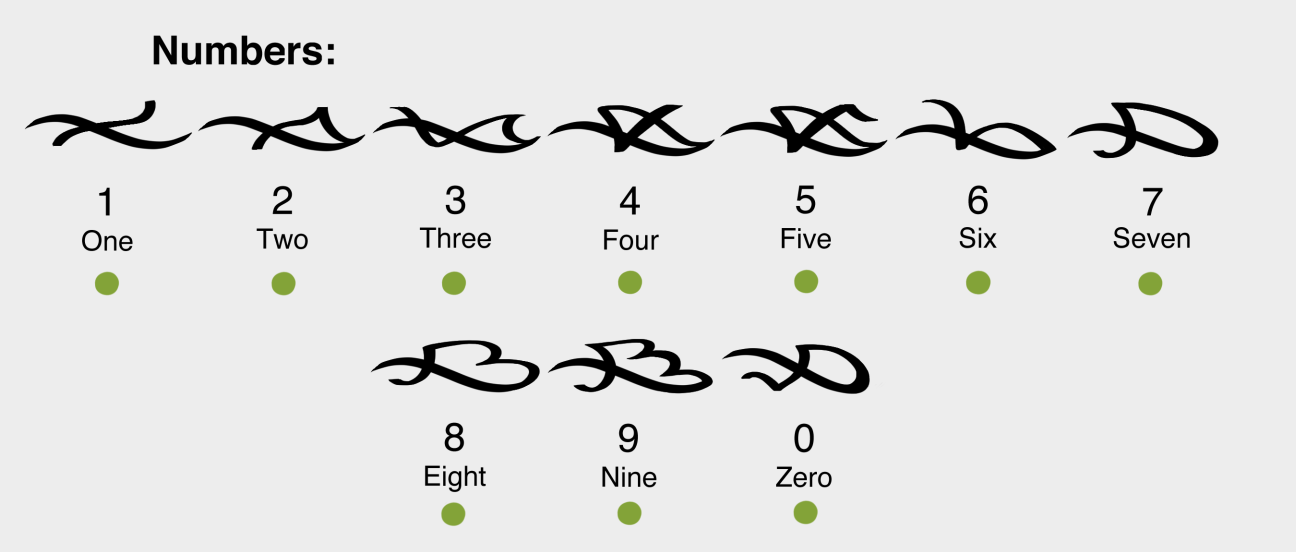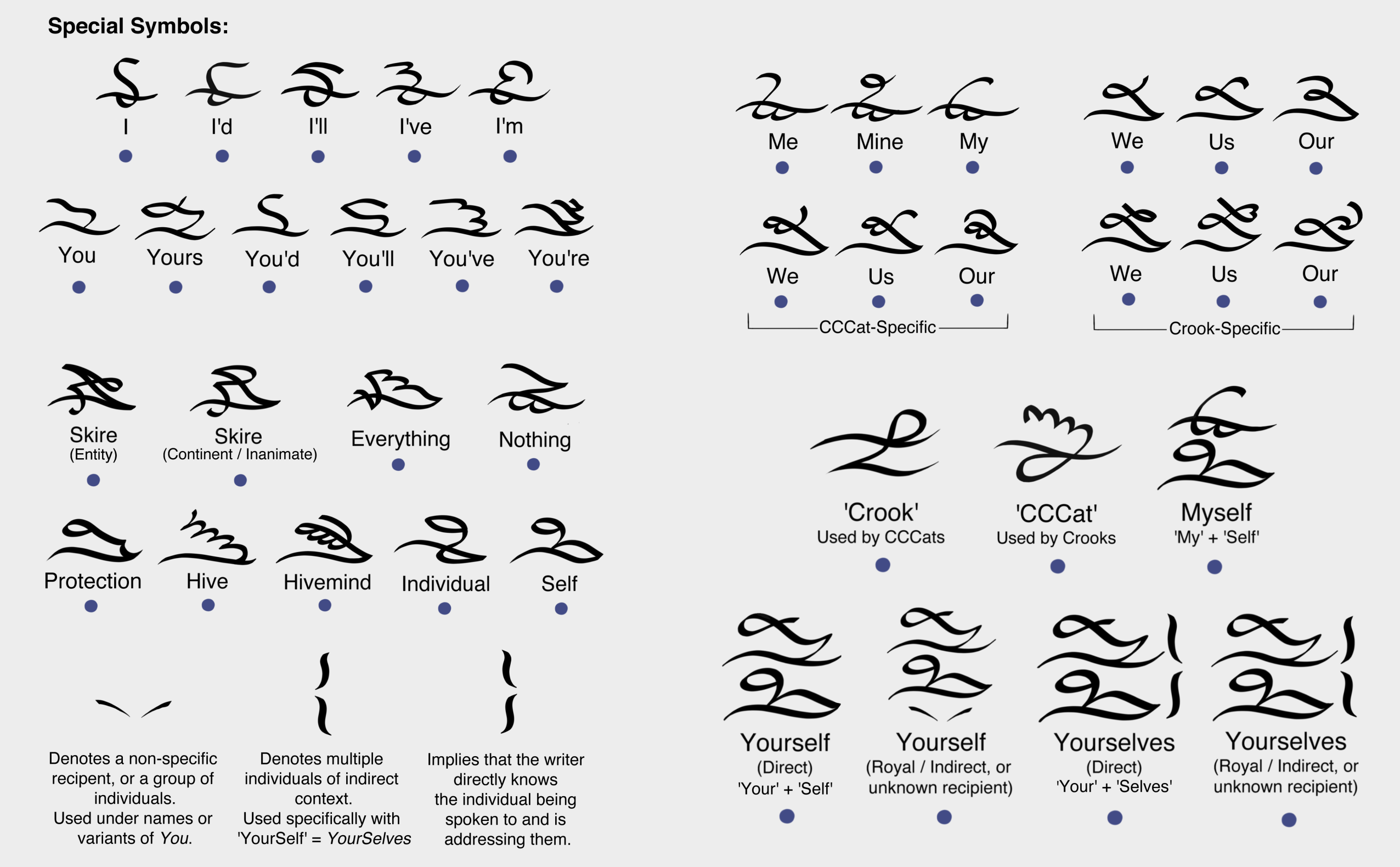
Word Structure
In Caster Speak, letters are based on a single curved line, upon which variations are attached. For consonants and consonant-based compound sounds, variations are attached either at the beginning or the end of the letter and are either above or below the line. These letters may then connect to form words in the shape of a ‘string’. While consonants can be kept separate if desired, they are usually strung together as follows:

Similar to accents, vowels are typically placed diagonally above and to the right of the consonant they follow. These vowels may connect to the consonant that comes before them, though variations of this rule are possible for creative freedom (I.E. choosing to have vowels detached instead, or placing the vowels between consonants as if they were consonants themselves).

In this example, the consonants for C and T are connected, and the phonetic for ‘ah’ attaches to the consonant before it. This results in the word for ‘cat’.

The most unique thing about Caster Speak is the amount of freedom given to the writer. Characters can uniquely portray their personalities through different styles of letters, personal handwriting, and variations in word structure. For example, one character may choose to leave both consonants and vowels detached in their handwriting, while another may connect their consonants and string their vowels instead, or even attach vowels and consonants on the same string.
Alphabet Breakdown
The written language of Skire (Landmass) uses a mostly complete alphabet (having a version of every letter in the Latin alphabet used in English), as well as a featural alphabet. The language also makes use of phonetics, which allows certain letters to represent sounds or pronunciations rather than a specific consonant.
Consonants and Compound Sounds
Like the English alphabet, Caster Speak has 21 regular consonants. These consonants are written larger than vowels and are used to portray basic speech sounds.
Some consonants create new sounds when used together (such as S and H making the ‘SH’ sound) and may have a symbol associated with this compound sound/phonetic. This means that, instead of writing the symbol for S and the symbol for H, you may choose to only write the symbol for 'SH' instead.

Vowels
In Caster Speak, vowels appear in ‘true forms', which are the five letters: A, E, I, O, U, and function the same as they do in English. These vowels also have phonetic variants, which can be used to display specific pronunciations and accents. For example, the letter for A has several phonetic variants, such as 'ah', and 'aw'.
Vowels can be easily identified in a text by their diacritics and smaller size in comparison to consonants.

Double Letters and Phonetics
As words in Caster Speak can be written phonetically, double consonants are in a strange limbo. While the letter isn’t truly pronounced twice, the presence of both letters can still be heard in its pronunciation. You can truly hear the rolling ‘r’ in the word ‘errand’, or the emphasis on the ‘g’ in ‘aggravate’. The use of these symbols implies that the original consonant would otherwise appear twice and therefore give a more enunciated pronunciation.

To display the influence of this double lettering without truly writing the letter twice, the writer has the option to ‘stack’ the consonant twice on the same curved line. For example, the letter for ‘T’ can be stacked on top of itself.
The most important thing to note about double letters and phonetics is that they are entirely optional to allow as much creative freedom to the writer. Because of this, the same word may have many possible spellings and pronunciations.
Numbers

Like the English language, Caster Speak has 10 unique symbols for numbers 1-9 and 0. In order to quantify something, these numerals would typically be placed under an item. For instance, the symbol for ‘5’ appearing below the word for ‘apple’ would imply that there are five apples. However, when describing a period of time, numbers will instead go above the descriptor (such as minutes, hours, days, or years).
Like consonants, numbers can be strung together to form bigger values (for example, the symbols for ‘1’ and ‘0’ would be ‘10’ when connected to each other). When writing dates, the year would appear first, followed by the day written above the month like so:

Unique Symbols
Certain words have a greater importance to CCCat and Crook culture and are therefore portrayed in unique symbols. This is the case for ‘Skire’, which has a version representing the continent, and one representing the Creator. There are also symbols referring to the Gods, known as The One Who Sees Everything (Everything) and The One Who Sees Nothing (Nothing). CCCats further have a symbol for ‘Hive’ and ‘Hivemind'. The word Protection (a group of Crooks with a common goal, trust, and/or a shared bond) has its own symbol as well.
CCCat culture is centered around one unique idea: finding a sense of self and individuality. For this reason, ‘individual’ and ‘self’ have their own symbols, both of which are variations of one another.
Several pronouns referring to oneself, or to whom the writer is referring to (I, You, We) have unique symbols with variations for contractions (I’d, I’ll, I’ve, I’m), and possessive pronouns (You vs. Yours, Me vs. Mine, etc.). CCCats and Crooks commonly use unique and differentiated ‘us/we’ pronouns when describing their species.
CCCats also have their own word for Crooks, though this word does not directly translate to ‘Crook’. Instead, it is better used to signify 'Half of the Hive', ‘One From Yet Apart’, or most notably ‘Similar Stranger’ — referring to Crooks born of the same Wormlings as CCCats, but no longer a part of the Hivemind. Crooks have their own word to describe their sibling species as well, though like the previous example, this word does not directly translate to ‘CCCat’. A better definition would be ‘Apart from the Many’, ‘One-Eyed Stranger’, or ‘Eye-Holders’. The first refers to CCCats’ separation from the Hivemind as a whole, while the two latter phrases refer to their singular, external eye (as opposed to Crooks’ many fused eyes).

Honor System and Accents
Some unique symbols can be stacked to create new words. For example, the symbol for ‘your’ can be stacked on top of the symbol for 'self', creating the compound symbol 'yourself'.

The order in which symbols are stacked functions in an ‘honor system’, where the top symbol is considered to be more superior or dominant than the lower symbol. This means that in the previous example, ‘you’ are the one who has ‘self’.
If the script is written vertically rather than horizontally, the symbol stacked on top would be at the left, while the symbol at the bottom would be at the right. Caster Speak is always read left-to-right and top-to-bottom (horizontally), or top-to-bottom and left-to-right (vertically).
This system has many cultural intricacies, especially in the eyes of CCCats and Crooks. For instance, writing a symbol describing oneself (I, Me, etc., as well as any species symbol) above the symbol for Skire (Entity) would be considered rude - or very bold - as it denotes a sentiment of being superior to Skire (Entity). However, inverting these symbols and putting the symbol for Skire (Entity) atop the symbol representing oneself, signifies a complete devotion to Skire (Entity)'s desire, and can be translated to ‘I am not for myself’. Because individuality and a sense of self are of immense importance, this statement deviates significantly from the values of the society and can be viewed as a bold choice of speech.
Combining a self-statement (I, me, etc.) symbol with the symbol for Skire (Landmass) implies that the individual/s are Skirean (from Skire). Writing the symbol for self above the one for Skire (Landmass) is more informal, whereas doing the opposite is more honorific. Using a species’ symbol rather than a self-statement implies that the species as a whole was ‘Born from Skire’ or is ‘from Skire’s Creation’.
Accent marks can be added to some special symbols to alter their meaning. Two curved lines pointed to the right (a broken curly bracket, like so: placed to the right of a symbol implies that the writer or speaker is communicating directly to the reader. In the case of a direct ‘yourself’, for example, this would suggest that the writer knows each ‘you’ that has ‘self’ in the context of the sentence it is used in. Curved lines pointed to the left signify an open, indirect, and implied plural ‘yourselves’ in which not all people addressed are necessarily known. Short lines placed below variants of You indicate a non-specific You (like “Thank you all for being here.”) and are used to indirectly address an individual and/or a group of individuals, rather than a specific individual or group.

This page was originally written by CassAttack9 and Syhren
Caster Speak's Visual Alphabet was created by kochkodachka